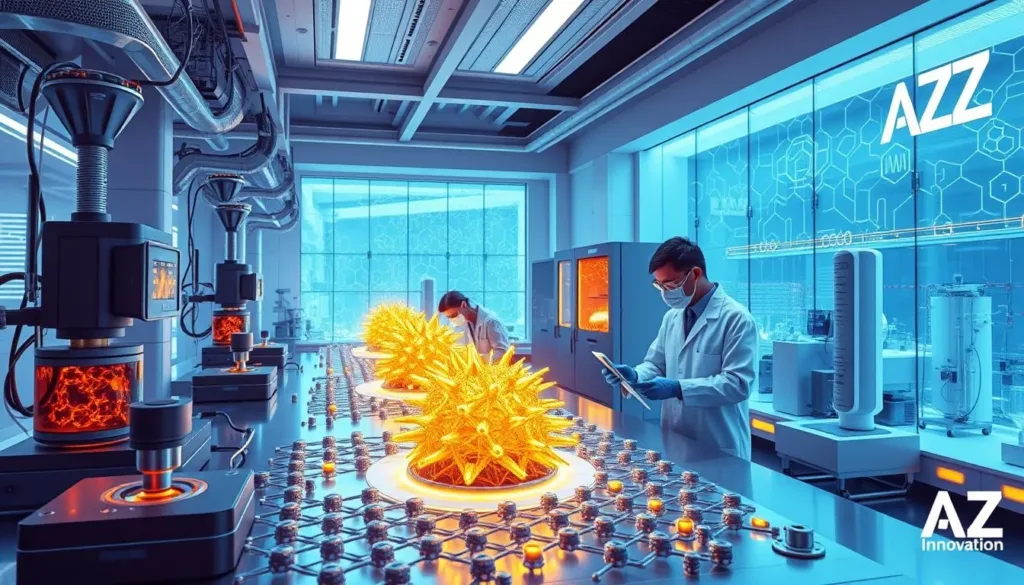Graphene: The Future of Advanced Materials & Nanotech

In a bustling research lab, scientists huddle around a microscope, captivated by what they see on the screen. They’ve just isolated a single layer of carbon atoms, a material poised to reshape the world as we know it. This discovery, graphene has astounding properties: it conducts electricity, is incredibly strong, allows light to pass through, and dissipates heat with ease. At just 0.33 nanometers thick, this tiny marvel is creating big waves across science and technology.
Key Highlights
- It’s unique hexagonal lattice structure and single-layer carbon arrangement give it remarkable abilities, such as excellent electrical conductivity, strength, optical transparency, and heat management.
- This groundbreaking material is sparking innovations in fields like electronics, energy storage, biomedical engineering, and environmental solutions.
- Advanced production techniques are making large-scale graphene manufacturing possible, paving the way for integration into today’s technologies.
- Its versatility is attracting industries from high-performance electronics and energy-efficient devices to advanced composite materials.
- Although challenges remain like addressing nanomaterial toxicity and refining fabrication methods the potential of graphene promises and exciting future.

What Makes Graphene Revolutionary?
Graphene’s remarkable properties are rooted in its molecular structure: a hexagonal lattice formed by a single layer of carbon atoms. Each carbon atom bonds to three neighbors, creating a robust yet ultra-thin structure with a powerful surface to volume ratio, responsible for graphene’s impressive optical, electrical, and mechanical traits.
- Hexagonal Lattice Architecture: Gr’s carbon atoms arrange themselves into a honeycomb-like hexagon pattern, giving it extraordinary mechanical strength. Its young’s modulus is about 1 TPa, thanks to the short bond length between carbon atoms.
- Single-Layer Carbon Configuration: At just one atom thick, graphene (Gr.) maximizes its surface area for enhanced interactions at the atomic level, making it a valuable asset in molecular engineering and high-performance electronic devices.
- Atomic-Scale Properties: Gr structure enables fast electron transport, making it ideal for high-frequency electronics. Its impressive thermal conductivity and light absorption also make it suitable for emerging technologies, from energy storage to optoelectronics.
The Discovery and Evolution of Graphene
Gr official discovery in 2004 by Andre Geim and Konstantin Novoselov at the University of Manchester sparked a revolution in materials science, earning them a Nobel Prize in 2010. Using the simple “Scotch tape method,” they isolated this elusive two-dimensional material, which had been theorized as far back as the 1940s.
With high strength, electrical and thermal conductivity, and optical properties, graphene continues to fascinate researchers and material engineers alike. Studies are underway worldwide, from twisted bilayer Gr to biomedical applications that explore its compatibility with the human body. For instance, Europe’s Gr Flagship project is investigating its interactions with the immune system, with potential applications in drug delivery and tissue engineering.
Exceptional Properties and Characteristics
Gr’s unique features set it apart as a material of the future:
- Mechanical Strength and Flexibility: Around 100 times stronger than steel, Gr can flex without breaking, which adds to its appeal for various applications.
- Electrical and Thermal Conductivity: Gr excels in conducting both electricity and heat, which opens doors in nanoelectronics, sensors, and heat dissipation technologies.
- Optical and Chemical Properties: Gr capacity to absorb light and interact chemically makes it suitable for applications in optoelectronics, sensors, and catalysis.
Modern Production Methods
Advanced manufacturing methods are paving the way for Gr’s large-scale production:
- Mechanical Exfoliation and CVD: While mechanical exfoliation is great for small samples, chemical vapor deposition (CVD) allows for scalable production of high-quality Gr, ideal for commercial uses.
- Molecular Beam Epitaxy (MBE): This precise technique uses a vacuum to create custom Gr structures, which is vital for specialized applications in molecular electronics.
Industry Applications
Graphene’s exceptional strength, flexibility, and conductivity make it a game-changer across many industries:
- Electronics and Quantum Technologies: With potential speeds up to 100 GHz, graphene is redefining electronics, enabling faster, more efficient devices. Researchers are also exploring electron-hole crystals and other quantum phenomena for advanced electronics.
- Aerospace and Energy Storage: In aerospace, Gr strength and conductivity benefit composite materials, while in energy storage, Gr-based devices could outperform traditional lithium-ion batteries.

Biomedical and Environmental Breakthroughs
Gr’s unique properties are opening up new possibilities in medicine and environmental science:
- Medical Diagnostics and Treatment: Gr-based sensors and wearables are helping monitor vital signs and assist people with neurological injuries in controlling devices, showcasing its flexibility and conductivity.
- Environmental Remediation: Gr effectiveness as a water purifier is also promising for sustainable environmental solutions.
Challenges and Future Prospects
While Gr potential is vast, challenges in mass production, fabrication, and integration with existing technologies persist. However, scientists are developing innovative methods like OF-CVD to produce higher-quality samples. Further research is focused on electron mobility and combining graphene with new materials, unlocking even more applications.
Conclusion
Gr is more than just a material; it’s a transformative force in advanced materials science and nanotechnology. As researchers continue to explore its capabilities and new production methods emerge, graphene is set to redefine fields from electronics to healthcare. We’re on the brink of a new era of innovation, with graphene leading the charge toward a smarter, more sustainable world.
